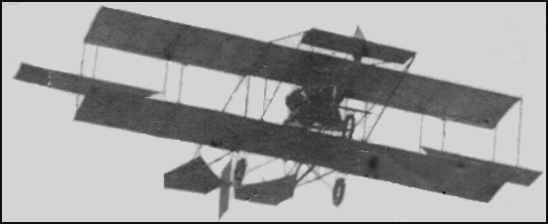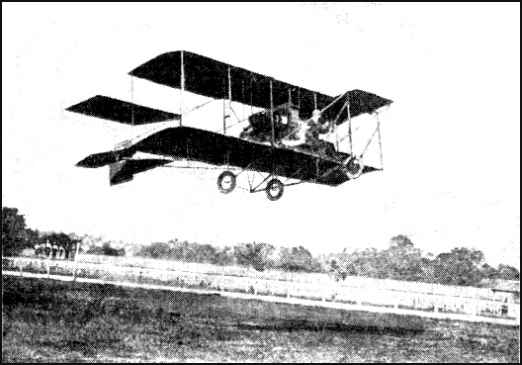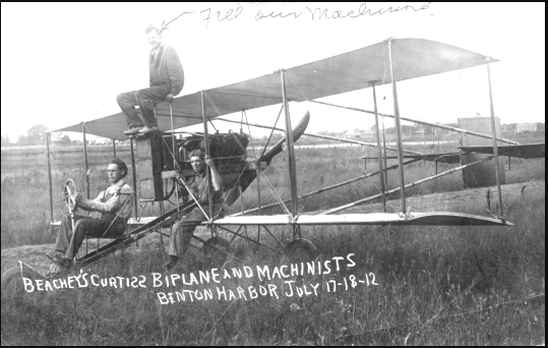
|
WALSH TESTS PLANE FOR ARMY To get things underway, the army sent a contingent of officers and enlisted men to Augusta, Georgia in the winter months. Their specific purpose was to make further investigation and conduct acceptance test of the new Curtiss military planes. Headed by Captain C. DeF. Chandler, and Capt. Paul Beck, Lt. T. DeMilling, USASC, and Lt. Col. C.B. Winder of the Ohio National Guard, the men arrived in mid-March and proceeded to set up tent hangers and living quarters along a flat stretch of bottom-cottonland along the Savannah River. In the meantime Curtiss shipped four pushers to Augusta for the trials--surely one would qualify. Glenn Curtiss was in San Diego at the time and found that Charlie Walsh, flying at Houston, was the best qualified pilot and the only one with enough flexibility in his schedule, at that crucial time, to fly the acceptance trials. He was directed to go to Augusta, as soon as possible, to see if he could get one of the planes there to do what the Army wanted. Charlie arrived March 14th and scheduled official trials to start on the 19th. In addition to Bill Fell, Curtiss had sent two special mechanics to help Walsh, James "Big Jim" LaMont and Louis "Little Lou" Crantz. The men had a ball. It was hard to be serious over trying to meet the specifications to the letter. The Army officers were just as interested and helpful im making the plane meet or come near the demands as was Curtiss. Flying would start at 8:00am every morning and while there was no problem meeting the top speed specification of 45 mph and remaining aloft and equivalent of four hours, based on the fuel consumed method of computation, the full load of 450 lbs-plus payload climb remained elusive even after extra wing panels were fitted for added lift. Charlie tried valiantly to meet the climb with load on several occasions, but failed. In the meantime, the officers got some dual time in and Charlie took everybody for a ride--everyone from Pvt. Arthur H. Mix (who would later become Lincoln Beachey's mechanic) to Harry Shearer, a local Augusta newspaperman. Even Big Jim and Little Lou had a few rides. The water was good for the cotton fields, but it could have been disastrous on airplanes. The planes were put on blocks in their tents to keep them above the swirling waters. The weather bureau didn't expect the swollen Savannah to recede for at least two weeks. After that the camp grounds and flying field would be so muddy that activities couldn't be carried out for another month. As far as the officers were concerned the Curtiss machine had passed all tests successfully except the climb to 2,000 feet in 10 minutes carrying some 475 pounds of weight. (1,000 feet in 5 minutes would have done it). The crew was ready to go home. |
 |
|
"Fell our Machinist was there. I and the children were in Hammondsport. - Alice Walsh" Collection of Ernie Sansome |
|
|
 |
|
"Well, we certainly got our money's worth today," as the universal expression of the people leaving the fair grounds after Aviator Charles F. Walsh, had concluded his Saturday afternoon's aeroplane flights, which were said by some who had been in attendance both days, to have even surpassed the remarkable exhibition of the preceeding day. Many visitors from vicinity towns were heard to say that they felt amply repaid for their trouble in making the second trip to see the airhsip flights, this having been the first opportunity that the majority of those on the grounds had ever had to view an airship at close range, a sight which all present were priviledged to enjoy, as the Curtiss biplane stood in the race track enclosure just opposite the grand stand until a few minutes before the flights when it was wheeled into position to make the start. It was at 2 o'clock, just after the ten-mile motorcycle race, that Walsh started on his first flight, remaining at a rather low altitude during this flight and keeping in the vicinity of the fair grounds, so that all might get a good clear view of the machine in operation. One of the most interesting features of the exhibition is the manner in which Walsh made his landings. These were accomplished with a grace and apparent ease that was truly marvelous, the aviator approaching the grounds in a long sweep from the south, skimming along for possibly seventy-five feet within a few inches of the ground and then settling so lightly on the wheels of the biplane so as to barely feel the slightest jar. In his second flight on Saturday afternoon, which was made after a fifteen minute interval, Walsh made a considerable longer trip and at a higher altitude, going to the east a couple of miles and then circling over the city so that he could again be plainly seen by people who were up town, hundreds having sought upper windows. roofs and other vantage points from which to watch the exhibition. Then returning to directly above the fair grounds he again performed the spiral glide and the long, sweeping dips, also the turkey trot and a variety of other exhibition "stunts,' all of which were much enjoyed by the spectators. At the conclusion of the second flight a large part of the crowd found its way into the enclosure and surrounding Walsh, cheered and applauded him, pushing forward in an effort to get near enough to shake hands with him. It is gratifying to The News to know that those who were in attendance at Friday's and Saturday's flights were so well pleased with them, the disappointment having naturally been keen as a result of the failure to give satisfactory flights on the original dates, but this feeling of disappointment having been fully dispelled by the very succrssful flights given by Walsh. Collection of Ernie Sansome |
 |
|
He takes off from Hamilton, Ohio, with mail in 1912 Collection of Ernie Sansome |
|
Six dates throughout Ohio opened the season. On two of these engagements Walsh carried
authorized U.S. Air Mail and at Lima, Ohio he put on a military demonstration of an airplane attacking well entrenched units of the National
Guard. The Guard "shot" their rifles at him.
From Ohio to Michigan, then to Iowa. At Dubuque he met his old classmate Lincoln Beachey where
they performed their head-on takeoff and raced each other and racing automobiles around the infield track. Charlie's next series of stops
were in Colorado.
"Charles F. Walsh flies first airplane at Fairgrounds (now Lincoln Park) 5,000 watch exhibition ." Quotation from Grand Junction History in Pictures Project Courtesy of Ernie Sansome |
 |
|
BENTON HARBOR JULY 17-18-12 "Fell our Machinist" Collection of Ernie Sansome |
| By September 1912, his exploits had taken him to Halifax, Nova Scotia for an unusually cold but thrilling exhibition. He returned for the fall season with a three day affair at Hempstead, Long Island. He created quite a sensation too; by flying up Broadway where thousands of New Yorkers looked up to see their first airplane fly over the Great White Way. |
|
ONLY EQUALLED PREVIOUS HEIGHTS The Wheeling Register September 6, 1912 Aviator Walsh Again Performed Dangerous Right-Hand Spiral. MULTITUDE SHOWS INCREASED INTEREST IN PERFORMANCES. Aviator Charles Walsh yesterday afternoon again gave the people of Wheeling an exhibition of altitude-flying and daring that equalled the wonderful flights of this birdman yesterday. The two flights were not quite so spectacular as those of the day before, but were equal in every other feature. Upon his descent from both flights Walsh was given an ovation surpassing anything received by any birdman before in this city. The feeble effort at hero worship given after his perfomances Wednesday could not compare with the genuine enthusiasm exhibited by the people yesterday. Prior to the flights, spectators lined the wire stretched across the infield to a depth of five and six persons. They waited behind the wire until the descents had been safely completed but after that there was no keeping the crowd back. Men, women and children swarmed under the wire and others darted across the race track. Walsh was surrounded by one knot of people while the machine was the center of interest of another. On all sides the talk was of Walsh's marvelous right-hand spirals exclusively explained in yesterday's Register. People of Wheeling had seen aviators defy the laws of gravitation, but Walsh was the first to defy the laws of aviation. The crowd that filled the infield yesterday was quick to show its appreciation of the man who displayed such daring. He made four additional circles around the fair grounds which brought him to a height of 2,000 feet. He went directly across the field to the east and started the right-hand spiral above the river. He made several turns and then wheeled to the right on the level, which then threw him in position for his landing. He was up exactly 13 minutes. It was eight minutes to five when the aviator left the ground for the second time during the afternoon. He made no fancy moves, but kept the nose of his machine constantly pointed up. He made seven complete circles that carried him three miles into Ohio and several miles down the river. When he reached 5,000 feet, Walsh started down. This time he chose the less dangerous left-hand spiral and made nine complete turns in the descent to about 1,000 feet. A long straight dip followed and one more left spiral when he sailed down over Exposition Hall to a landing. |
| Alice and the children, Juanita and Kenneth, were getting tired to travel. They had done some prized shopping in New York City during Charlie's Hempstead dates. They wanted to go back to the people they knew and liked best at Hammondsport for awhile. This was the first time they would not be with Charlie since he started his exhibition flying in the spring of 1911. His next engagement was to be Pittsburgh, Pennsylvania but he wouldn't fly there. For some unknown reason, none of the pioneer airmen like to fly in or around Pittsburgh; many refused as had Walsh. Whether there weren't suitable fields or the air currents weren't right, no one seems to know. Fanciulli accepted Walsh's refusal and reschedule his next date for October 3, at the Interstate Fairgrounds in Trenton, New Jersey. |
|
|